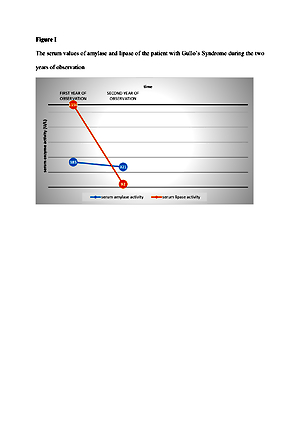Online first
About the Journal
Current issue
Archive
Publication Ethics
Anti-Plagiarism system
Instructions for Authors
Instructions for Reviewers
Editorial Office
Editorial Board
Contact
Reviewers
All Reviewers
2025
2024
2023
2022
2021
2020
2019
2018
2017
2016
General Data Protection Regulation (RODO)
CASE REPORT
Gullo’s Syndrome – case report
1
Department of Gastroenterology with Endoscopy Unit, Medical University, Lublin, Poland
2
Gastroenterology Unit, Independent Public Teaching Hospital No. 4, Lublin, Poland
Corresponding author
J Pre Clin Clin Res. 2020;14(4):117-119
KEYWORDS
amylaselipaseGullo’s Syndromebenign pancreatic hyperenzymemia (BPH)elevated pancreatic enzyme activitypancreatic hyperenzymemiapancreatic enzymes (PE)
TOPICS
ABSTRACT
Benign pancreatic hyperenzymemia (BPH) or Gullo’s Syndrome is a persistent elevation of pancreatic enzymes activity, observed for at least one year, with no pancreatic disorder. This diagnosis is extremely important because it allows us to avoid many unnecessary examinations performed during the diagnostic process. The case is presented of a 25-year-old man who was examined for recurrent elevated lipase and amylase serum values over a time period of 2 years who presentedwith non-specific abdominal complaints. Interestingly, his routine tests showed sustained elevated serum amylase and lipase activity. He was intensively diagnosed due to pancreatic hyperenzymemia, but no pancreatic disease was detected. The observation lasted two years. The serum lipase and serum amylase levels continued to increase after that time. This diagnosis requires attention because BPH can be the first symptom of pancreatic cancer.
ABBREVIATIONS
BPH – benign pancreatic hyperenzymemia
PE – pancreatic enzymes
HIV – human immunodeficiency virus
CEA – carcinoembryonic antigen
CA19-9 – carbohydrate antigen 19-9
AFP – alpha-fetoprotein
CA125 – carbohydrate antigen 125
NOD2 – nucleotide-binding oligomerization domain
containing 2
PRSS1 – serine protease 1
SPINK1 – serine protease inhibitor Kazal-type 1
CAPH – chronic asymptomatic pancreatic hyperenzymemia
EUS – endoscopic ultrasonography
s-MRCP – secretin-magnetic resonance cholangiopancreatography
MRCP – magnetic resonance cholangio-pancreatography
FUNDING
No funding was received.
CONFLICT OF INTEREST
The authors declare that they have no competing interests.
Rycyk A, Furtak P, Mądro A, Kasztelan-Szczerbińska B, Cichoż-Lach H. Gullo’s Syndrome: case report. J Pre-Clin Clin Res. 2020; 14(4): 117–119. doi: 10.26444/jpccr/127792
REFERENCES (14)
1.
Mehta P, Reddivari AKR. A Case Report of Benign Pancreatic Hyperenzymemia (Gullo‘s Syndrome). Cureus. 2020 May 15; 12(5): e8143.
2.
Kumar P, Ghosh A, Tandon V, et al. Gullo‘s Syndrome: A Case Report. J Clin Diagn Res. 2016 Feb; 10(2): OD21-OD22.
3.
Ainahi A, Ziane A, Wakrim L, et al. An Unusual Case of Gullo‘s Syndrome Concomitant with Serious Endometriosis Disease in a Postmenopausal Woman. Case Rep Med. 2018; 2018: 6310245.
4.
Schnedl WJ, Enko D, Mangge H, et al. Benign pancreatic hyperenzymemia (Gullo syndrome), histamine intolerance, and carbohydrate malabsorption. Proc (Bayl Univ Med Cent). 2017 Apr; 30(2): 177–178.
5.
Yang BL, Wu WC, S u CW, et al. Healthy Chinese with benign pancreatic hyperenzymemia. J Chin Med Assoc. 2015; 78(10): 623–6.
6.
Heim VJ, Stafford CA, Nachbur U. NOD Signaling and Cell Death. Front Cell Dev Biol. 2019; 7: 208.
7.
Rosell-Camps A, Martínez-Cepas P, Riera-Llodrá JM, et al. Benign Pancreatic Hyperenzymemia, Also Known as Gullo‘s Syndrome. Lab Med. 2019. pii: lmz077.
8.
Lionetti E, Francavilla R, Leonardi S, et al. Two rare cases of benign hyperlipasemia in children. World J Clin Cases. 2014; 2(1): 16–9.
9.
Liverani E, Leonardi F, Castellani L, et al. Asymptomatic and persistent elevation of pancreatic enzymes in an ulcerative colitis patient. Case Rep Gastrointest Med. 2013; 2013: 415619.
10.
Di Leo M, Petrone MC, Zuppardo RA, et al. Pancreatic morphofunctional imaging as a diagnostic approach for chronic asymptomatic pancreatic hyperenzymemia. Dig Liver Dis. 2016; 48(11): 1330–1335.
11.
Vanella G, Arcidiacono PG, Capurso G. Chronic Asymptomatic Pancreatic Hyperenzymemia (CAPH): Meta-analysis of pancreatic findings at second-level imaging. Pancreatology. 2019; 19(2): 237–244.
12.
Amodio A, De Marchi G, Granato A, et al. Chronic Asymptomatic Pancreatic Hyperenzymemia: A Long-term Follow-up. Pancreas. 2019; 48(4): 544–547.
13.
Catanzaro R, Sciuto M, Adamo G, et al. Benign pancreatic hyperenzymemia-Gullo‘s syndrome: focus on this clinical challenge. A monocentric retrospective study. Minerva Med. 2019 Dec; 110(6): 490–498.
14.
Pezzilli R, Brighi N, Calculli L. Quality of life in patients with longstanding chronic non-pathological pancreatic hyperenzymemia. Pancreatology. Mar-Apr 2015; 15(2): 131–5.
We process personal data collected when visiting the website. The function of obtaining information about users and their behavior is carried out by voluntarily entered information in forms and saving cookies in end devices. Data, including cookies, are used to provide services, improve the user experience and to analyze the traffic in accordance with the Privacy policy. Data are also collected and processed by Google Analytics tool (more).
You can change cookies settings in your browser. Restricted use of cookies in the browser configuration may affect some functionalities of the website.
You can change cookies settings in your browser. Restricted use of cookies in the browser configuration may affect some functionalities of the website.


